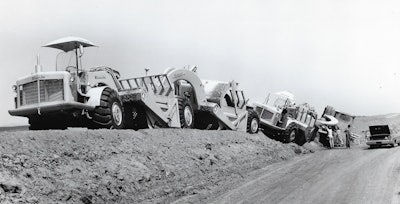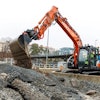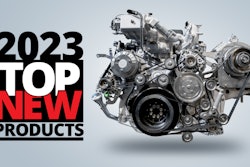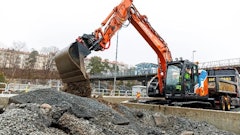
In our ongoing study of scraper technology, we last looked at the concept of lashing up multiple scrapers under the control of a single operator, primarily by adding one or more scraper bowls to the one being operated. But the concept didn’t end there.
During excavation of the San Luis Canal in California’s San Joaquin Valley in the mid-1960s, the combination of suitable material, (hoped-for) economics and work areas that were, at least in theory, spacious enough to allow room to maneuver gave rise to three variations on an even wilder idea – multiple motor scrapers, tractors and all, controlled from one machine. As it turned out, there was a right way and two wrong ways to do this.
Euclid’s two-bowl, three-engine Tandem TS14 was mentioned in the last issue. One wrong way was lashing two of these together into a 135-foot-long green snake on wheels with six powered axles and five pivot points – two for each Tandem TS-14 plus the fifth at the pivot between them. The operator controlled it from the lead tractor. All this caused it to writhe as it moved, with 10 to 15 feet of side play at the rear scraper, and the idea came to an end when all this play caused a tire on the last scraper to go over the edge of the berm and slowly pull most of the rest of the machine over with it.
The other wrong way, and the right way, involved Caterpillar 657s. Two tandem sets and one 186-foot-long triple set were assembled by dealer Peterson Tractor Company. The triple set, like that tandem Tandem TS-14, was hard to manage. Even with the operator in an elevated cockpit above the lead scraper’s engine for visibility, it was also like driving a snake, and finally doomed itself by bogging down in soft going. The tandem 657s, which were controlled from the lead tractor, proved much more practical, and purchase of a single 657 led to the triple being split into two doubles.
Peterson was awarded patents in 1966 for the tandem 657’s steering and operating controls and 1967 for the triple’s accelerator system. When Cat wanted to revisit the idea of tandem scrapers through the ability to temporarily hitch two machines together for mutually assisted loading, it called on Peterson’s experience with these machines; the result was another patent issued in September 1967 for what became the push/pull system of a hook-and-bail arrangement temporarily connecting two or more scrapers to help each other load. The system is still in use, and Terex and others also offered similar systems.
The Historical Construction Equipment Association (HCEA) is a 501(c )3 non-profit organization dedicated to preserving the history of the construction, dredging and surface mining equipment industries. With over 3,500 members in a dozen countries, our activities include operation of National Construction Equipment Museum and archives in Bowling Green, Ohio; publication of a quarterly magazine, Equipment Echoes, from which this text is adapted, and hosting an annual working exhibition of restored construction equipment. Individual memberships are $35.00 within the USA and Canada, and $55.00 US elsewhere. Our next International Convention and Old Equipment Exposition will be September 22-24, 2023, in Bowling Green, Ohio. We seek to develop relationships in the equipment manufacturing industry, and we offer a college scholarship for engineering students. Information is available at www.hcea.net, or by calling 419-352-5616 or e-mailing [email protected].

















